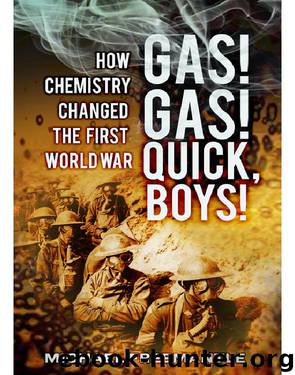Freemantle by Gas! Gas! Quick Boys! How Chemistry Changed the First World War (2012)

Author:Gas! Gas! Quick, Boys! How Chemistry Changed the First World War (2012)
Format: epub
Published: 2014-06-16T04:00:00+00:00
Tear gases
A dozen or more organic chemicals were employed as tear gases, also known as lachrymators, by the combatant armies in the First World War. As these chemicals were used as non-lethal irritants rather than lethal agents, none of the belligerent nations considered them to contravene the Hague Convention of 1899.
The concept of using tear gases against enemy troops dates back to the nineteenth century when Scottish chemist William Ramsay (1852–1916) carried out experiments on acrolein, a flammable liquid with a pungent smell. The organic chemical, also known as 2-propenal or acrylic aldehyde, was produced by the decomposition of the glycerine formed when tallow, a form of animal fat or grease, was burnt.
Ramsay is more famous for the discovery, along with other scientists, of the chemical elements argon in 1894, helium in 1895, and krypton, neon and xenon in 1898. These elements, which are renowned for their lack of chemical reactivity, are known as inert or noble gases. Ramsay is the only person to have discovered an entire group of elements in the Periodic Table of Chemical Elements. In 1904, he was awarded the Nobel Prize in Chemistry ‘in recognition of his services in the discovery of the inert gaseous elements in air, and his determination of their place in the periodic system’.
Following his experiments on acrolein, Ramsay suggested to the British War Office that the compound could be employed as a tear gas against an enemy, although they decided not to use it.28 The French, on the other hand, introduced the chemical in January 1916 as a filling for gas grenades and artillery gas shells.29 It was not a great success, however, as the material is chemically unstable in air. Acrolein is unique among the lachrymators used in the First World War in that it does not contain chlorine, bromine or iodine. These three chemical elements, known as halogens, form part of the group of elements next to the group of inert gases in the periodic table.
The first tear gas, and indeed the first chemical warfare agent, to be used in the war was an organic chemical containing bromine. The chemical, a colourless liquid with a pungent odour, was ethyl bromoacetate. Two British organic chemists, William Henry Perkin (1838–1907) and Baldwin Francis Duppa (1828–1873), reported the preparation of the compound in a paper published in a German chemistry journal in 1858.30 They prepared the compound by treating acetic acid with bromine and then combining the product, bromoacetic acid, with ethanol.
According to some reports, the French police used ethyl bromoacetate as tear gas as early as 1912 to help them capture criminals.31 Ludwig Haber (1921–2004), the son of Fritz Haber who developed an efficient way of synthesising ammonia, disputes such reports in his book on chemical warfare in the First World War.32 He notes that two chemists at the municipal laboratory in Paris had recommended the use of the chemical agent to the police for riot control, but the police did not use it. Two years later, however, the French did use ethyl bromoacetate as tear gas.
Download
This site does not store any files on its server. We only index and link to content provided by other sites. Please contact the content providers to delete copyright contents if any and email us, we'll remove relevant links or contents immediately.
| Africa | Americas |
| Arctic & Antarctica | Asia |
| Australia & Oceania | Europe |
| Middle East | Russia |
| United States | World |
| Ancient Civilizations | Military |
| Historical Study & Educational Resources |
The Radium Girls by Kate Moore(11619)
100 Deadly Skills by Clint Emerson(4688)
The Templars by Dan Jones(4556)
Rise and Kill First by Ronen Bergman(4543)
The Doomsday Machine by Daniel Ellsberg(4243)
The Rape of Nanking by Iris Chang(4021)
Killing England by Bill O'Reilly(3896)
Hitler in Los Angeles by Steven J. Ross(3797)
Stalin by Stephen Kotkin(3724)
12 Strong by Doug Stanton(3418)
Hitler's Monsters by Eric Kurlander(3161)
Blood and Sand by Alex Von Tunzelmann(3055)
Darkest Hour by Anthony McCarten(3017)
The Code Book by Simon Singh(2855)
The Art of War Visualized by Jessica Hagy(2836)
Hitler's Flying Saucers: A Guide to German Flying Discs of the Second World War by Stevens Henry(2621)
Babylon's Ark by Lawrence Anthony(2427)
The Second World Wars by Victor Davis Hanson(2420)
Tobruk by Peter Fitzsimons(2373)
